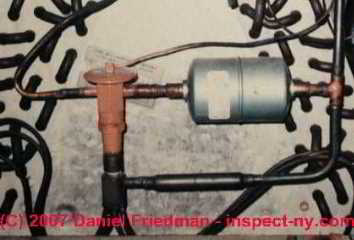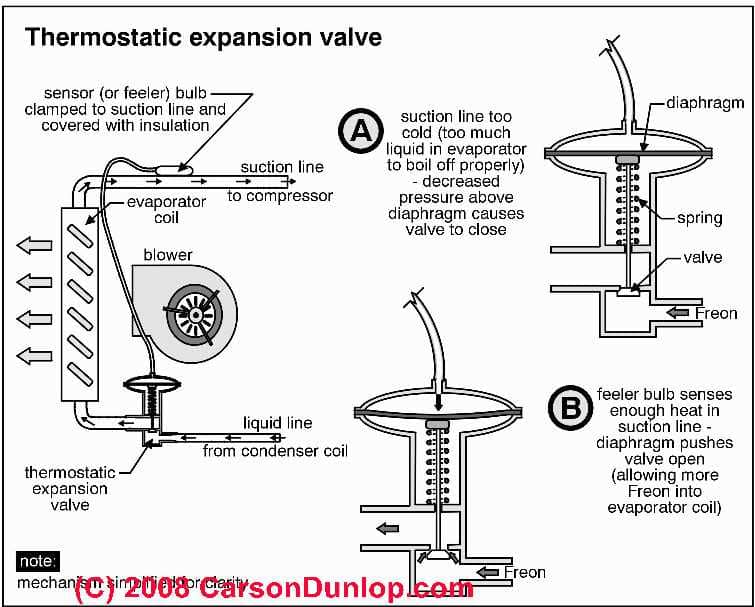 Subcooling
Subcooling
Definition, measurement, use of subcooling in HVACR
- POST a QUESTION or COMMENT about HVACR system subcooling measurements, uses, definition
Subcooling: for installing or repairing air conditioners, heat pumps, and refrigerantion equipment, what is the definition of subcooling and how is that term used?
InspectAPedia tolerates no conflicts of interest. We have no relationship with advertisers, products, or services discussed at this website.
- Daniel Friedman, Publisher/Editor/Author - See WHO ARE WE?
Defintion of Subcooling

This article discusses and defines subcooling, a term used in refrigeration, air conditioning, and heat pump design, installation, & repair.
[Click to enlarge any image]
Schematic of a thermostatic expansion valve courtesy of Carson Dunlop Associates.
Danfoss (2005) TEV fitters notes provides details about subcooling on HVACR equipment, from which we quote this excerpt:
Definition of Subcooled Refrigerant
A sub-cooled liquid refrigerant is at a temperature below (colder-than) the temperature at which the refrigerant would evaporate ("boil" or change from a liquid refrigerant to a gas - also called the refrigerant saturation temperature).
Subcooling is defined as the difference between condensing pressure/temperature and liquid temperature at the expansion valve inlet.
Subcooling of the refrigerant is necessary to avoid vapour bubbles in the refrigerant ahead of the expansion valve.
Vapour bubbles in the refrigerant reduce capacity in the expansion valve and thereby reduce liquid supply to the evaporator.
Subcooling of 4-5K is adequate in most cases. - Danfoss (2005)
Measurement of Subcooling
Subcooling is measured in Kelvin (K) or °C.
Subcooling temperatures are measured on the refrigerant line just ahead of (supplying refrigerant into) the TEV.
Subcooling is measured in degrees of temperature (on any scale) and can be defined as the difference in temperature degrees between the liquid refrigerant's saturation temperature and the current or actual liquid refrigerant temperature.
Higher subcooling temperatures of a liquid refrigerant mean a more efficient HVACR system operation beause more heat is being removed per unit volume (or unit weight) of refrigerant circulating in the system.
Thus some HVACR technicians measure subcooling to take a look at the operating efficiency of the system and to compare it with the manufacturer's specifications. Higher subcooling numbers mean that the equipment will have to run less time to adequately cool the area being refrigerated or air conditioned.
Lower or too-low subcooling temperatures risk accidental conversion of liquid refrigerant to gas state within the piping system before it reaches the refrigerant metering device (capillary tube or thermostatic expansion valve (TEV)), reducing the efficiency of the system and possibly interfering with the proper operation of the TEV. - adapted from Emerson Climate Technologies (2005)
Thank you to our readers for their generous comments
(June 30, 2011) James Wrobel said: This is an extremely useful article. Well done.
(July 18, 2011) rhomz said: thankz for this article,i have learned a lot
(July 19, 2011) Ervin Berrios said: Thanks guys, this explanation is very helpfull to me, as I'm learning and working in AC in residential. Now I have a very reliable information to provide to my customers
(Sept 13, 2011) George Martinez said: Thank you very informative article.
...
...
Continue reading at DEFINITION of HEATING, COOLING & INSULATION TERMS - topic home, or select a topic from the closely-related articles below, or see the complete ARTICLE INDEX.
Or see these
Recommended Articles
- DEFINITION of HEATING, COOLING & INSULATION TERMS - home
- DEFINITION of HEAT FLOW DIRECTION
- DEFINTION of JOULE
- DEFINITION of LATENT HEAT
- DEFINITION of SEER RATINGS
- DEFINITION of SENSIBLE HEAT
- DEFINITION of SUBCOOLING
- DEFINITION of SPECIFIC HEAT
- DEFINITION of SUPERHEAT
- REFRIGERANT PRESSURE READINGS & CHARTS - home
- THERMOSTATIC EXPANSION VALVES
Suggested citation for this web page
SUBCOOLING DEFINITION at InspectApedia.com - online encyclopedia of building & environmental inspection, testing, diagnosis, repair, & problem prevention advice.
Or see this
INDEX to RELATED ARTICLES: ARTICLE INDEX to AIR CONDITIONING & HEAT PUMPS
Or use the SEARCH BOX found below to Ask a Question or Search InspectApedia
Ask a Question or Search InspectApedia
Try the search box just below, or if you prefer, post a question or comment in the Comments box below and we will respond promptly.
Search the InspectApedia website
Note: appearance of your Comment below may be delayed: if your comment contains an image, photograph, web link, or text that looks to the software as if it might be a web link, your posting will appear after it has been approved by a moderator. Apologies for the delay.
Only one image can be added per comment but you can post as many comments, and therefore images, as you like.
You will not receive a notification when a response to your question has been posted.
Please bookmark this page to make it easy for you to check back for our response.
IF above you see "Comment Form is loading comments..." then COMMENT BOX - countable.ca / bawkbox.com IS NOT WORKING.
In any case you are welcome to send an email directly to us at InspectApedia.com at editor@inspectApedia.com
We'll reply to you directly. Please help us help you by noting, in your email, the URL of the InspectApedia page where you wanted to comment.
Citations & References
In addition to any citations in the article above, a full list is available on request.
- Danfoss Thermostatic Exansion Valves, Type TE / TE2, Danfoss Refrigeration & Air COnditioning Division, Danfoss Ltd., Oxford Rd., Denham, Bucks UB9 4LH, UK, Tel: 0879 241 7041, Email: uk.refrigeration.sales@danfoss.com Website: www.danfoss.co.uk - retrieved 8/31/2014, original source op cit.
- Danfoss Thermostatic Expansion Valves, Fitters Notes, RZ1AH202 → DKRCC.PF.A00.A1.02 / 520H0337, Danfoss A/S (2005),
- Sporlan Thermostatic Expansion Valves Identification [Guide], Bulletin 210-60 (1994), Danfoss Refrigeration & Air COnditioning Division, Danfoss Ltd., Oxford Rd., Denham, Bucks UB9 4LH, UK, Tel: 0879 241 7041, Email: uk.refrigeration.sales@danfoss.com Website: www.danfoss.co.uk - retrieved 8/31/2014, original source op cit.
- [1] "Thermostatic Expansion Valve Installation Instructions", Singer Controls Division, Schiller Park IL, 1979 parts brochure
- [2] Christopherson, Norm, "Preventing Premature Compressor Failures, An Ounce of Prevention for Years of Service", web search & reader TN Goose referral, 08/12/2011, original source: http://www.hvacfun.com/a-once-prevent-years-service-comps.htm
- Emerson Climate Technologies, "Quick Facts: Superheat and Subcooling", (2005) Flow Controls Division of Emerson Climate Technologies (formerly Alco Controls), Website: www.emersonclimatecontractor.com, retrieved 7/22/2014, original source http://www.achrnews.com/articles/quick-facts-superheat-and-subcooling
- Our recommended books about building & mechanical systems design, inspection, problem diagnosis, and repair, and about indoor environment and IAQ testing, diagnosis, and cleanup are at the InspectAPedia Bookstore. Also see our Book Reviews - InspectAPedia.
- Complete List of Air Conditioning & Heat Pump Design, Inspection, Repair Books at the InspectAPedia Bookstore.
- In addition to citations & references found in this article, see the research citations given at the end of the related articles found at our suggested
CONTINUE READING or RECOMMENDED ARTICLES.
- Carson, Dunlop & Associates Ltd., 120 Carlton Street Suite 407, Toronto ON M5A 4K2. Tel: (416) 964-9415 1-800-268-7070 Email: info@carsondunlop.com. Alan Carson is a past president of ASHI, the American Society of Home Inspectors.
Thanks to Alan Carson and Bob Dunlop, for permission for InspectAPedia to use text excerpts from The HOME REFERENCE BOOK - the Encyclopedia of Homes and to use illustrations from The ILLUSTRATED HOME .
Carson Dunlop Associates provides extensive home inspection education and report writing material. In gratitude we provide links to tsome Carson Dunlop Associates products and services.

